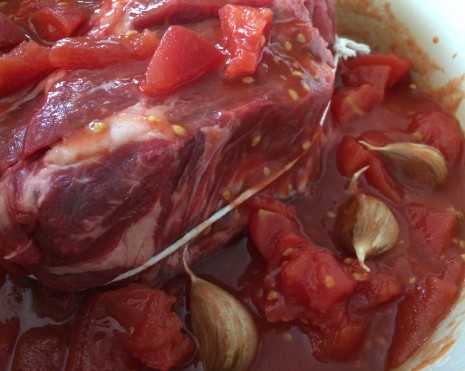RECIPE FOR HAPPINESS: OVEN-BRAISED BEEF WITH TOMATO SAUCE AND GARLIC
A braise, with its deep, soulful flavor and lush texture, is a stellar example of what can happen when household economy meets benign neglect. Take an inexpensive cut of meat, put it in a heavy pot, brown it (or not, as the case may be), add a small amount of liquid, and let it cook, covered, in the oven for a few hours. In the interim, you can get another meal working on the stovetop. Or, since a braise is such a great party dish (it’s virtually impossible to ruin and at its best when made a day ahead), you can plan an impromptu dinner party. Or, like Zanne Stewart, who developed the recipe below for Gourmet close to 15 years ago, you can get comfortable on the floor and play with your child.
Generally speaking, braising means long, slow, moist cooking—a pot roast, in other words. This unhurried, transformative technique, which incorporates boeuf à la mode and its gently poached cousin pot-au-feu, is one of the cornerstones of French cuisine, as Jim Peterson points out in his Glorious French Food. He goes on to explain how a traditional boeuf à la mode is made with red wine and beef broth, which, in old-fashioned farmhouse cooking, is taken straight from a pot-au-feu—a welcome reminder that “thrift” is often a synonym for “delicious.”
And on several different levels. The last thing you want is the sort of expensive cut of meat that yields steaks and roasts. Nope, the key to success is a cheap, semi-tough cut such as beef chuck roast, known for its balance of rich meat, beautiful white fat, and collagen, which breaks down into silky gelatin during long, moist cooking. The correct cut, not the braising liquid, is primarily what keeps the meat juicy. Other key factors include the right-size heavy pot (the meat should fit fairly snugly inside) and braising liquid that stays at a bare simmer.
Although you can braise a dish on the stovetop, it’s much easier to regulate the temperature in the even, indirect heat of the oven, which is also closer in spirit to the original method. “When cooking was carried out directly on the hearth, braising meant cooking slowly in hot embers,” states the encyclopedic Larousse Gastronomique (2009 rev. ed.). “The cooking container had a lid with a rim on which embers could be placed, so that the heat came from both above and below.” If I had one of those, it would almost make me want to go camping.
A braise will not be rushed. It cooks in its own good time, and there is really nothing you can do to chivvy it along, which is rather freeing, when you think about it. As far as doneness goes, you should be able to slide a kitchen fork in and out of the meat with absolutely—I mean, absolutely—no resistance. That’s one definition of “fork-tender,” but trust Webster’s to cover all the bases; the term also means “tender enough to be cut by a fork.” Although you’ll need to cut slices of the braised beef below with a knife, the slices themselves are cuttable with a fork—a boon if you haven’t let the lack of a dining table prevent you from inviting people to dinner.
The recipe below is staggeringly simple, and it achieved immediate cult status among the Gourmet staff. It’s fabulous with orzo, the suggested accompaniment, but mashed potatoes are delicious, too. Later in the week, shred any leftover meat and serve it and the remaining sauce, ragù style, over egg noodles.
Oven-Braised Beef with Tomato Sauce and Garlic
From The Gourmet Cookbook
Serves 6
This recipe calls for chopping the tomatoes in their juice in a food processor. I rarely take the time to haul ours out of the cupboard; instead, I fish the tomatoes out of the can (saving the juice) and chop them by hand. Or, in a Peg Bracken–style maneuver, I just hack away at the tomatoes in the can with a pair of kitchen scissors. As far as tying the meat goes, I learned from the New York City butcher Stanley Lobel to use a light hand so the string doesn’t cut into the meat (thus releasing juices) as it cooks. The chuck roasts I see are thick and blocky, so I just make one or two loops around the sides; that’s enough to keep the roast together for those hours in the oven. And, like all braises, this improves in flavor if made a day ahead. Cool it completely in the braising liquid, uncovered, then cover and refrigerate. Remove the excess fat before reheating.
1 (28-ounce) can of whole tomatoes in juice
1 (3- to 3½-pound) boneless beef chuck roast, tied with kitchen string
1 head garlic, separated into cloves but left unpeeled
Coarse salt and freshly ground black pepper
Accompaniment: cooked orzo
1. Put a rack in the middle of the oven and preheat oven to 300ºF. Coarsely chop tomatoes, with their juice, in a food processor. Put the chuck roast in an ovenproof 4- to 5-quart heavy pot or casserole dish with a lid, pour tomatoes over it and scatter garlic around it. Season with salt and pepper.
2. Cover and braise in oven until very tender, 3 to 4 hours. Remove and discard string. Cut into ¼-inch-thick slices and serve with sauce, orzo, and garlic.
Posted: January 28th, 2014 under cooking, Gourmet magazine, people + places, recipes, winter.


